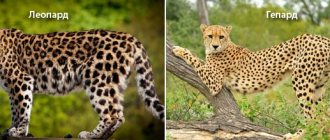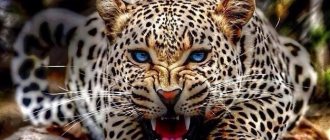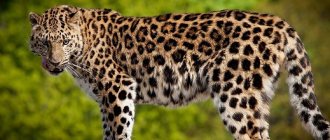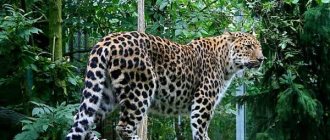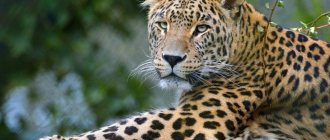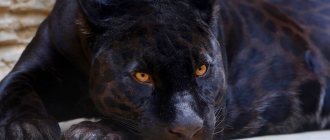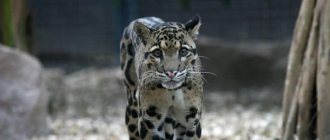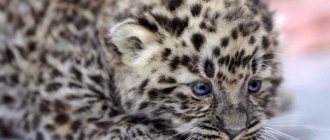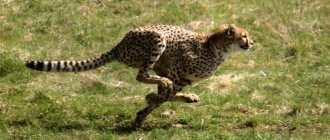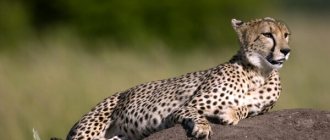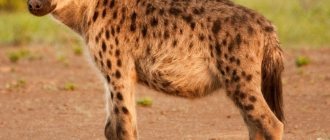The leopard and cheetah are Africa's two top predators. Both are large cats and rivals to prey such as Thompson's gazelles and other small antelopes. Both are beautiful, strong and endangered animals, but there are striking differences between them.
Although they are spotted cats, leopards and cheetahs are not as closely related. The leopard belongs to the genus Panthera, along with the lion, tiger and jaguar. The cheetah is the only representative of the genus Acinonyx. Its closest relative in the cat family is the puma.
The leopard is stronger than the cheetah, and indeed, leopards and lions often kill cheetah cubs to remove them as future competitors. On the other hand, the cheetah is known to be faster than the leopard over short distances and is one of the fastest land animals on Earth. Despite its speed, the cheetah is not as good a hunter as the leopard. The leopard is not only bigger and stronger, but also patiently stalks its prey. Cheetahs can also be domesticated and are sometimes kept as pets for people who know how to care for these amazingly fragile and demanding animals. The much less docile leopard is never kept as a pet. Read on to see some more comparisons between leopard and cheetah.
Siamese cat
Siamese cats are playful, active, sometimes noisy and quite demanding. Their cheerful intelligence allows them to do many complex things, such as turning on faucets, switching lights, and opening cabinets. To keep her entertained, you'll have to give her puzzle toys, exercise, and maybe even agility training.
What speed does a leopard develop in km/h?
The maximum speed that a predator can reach is 50 kilometers per hour. Compared to the fastest animal (the cheetah), this is a relatively modest result. The speed of the latter is 110 kilometers per hour or more.
It should be noted that leopards do not waste their energy. They do not pursue their prey at high speeds, but simply follow it and lure it. However, sometimes they have to use their agility and dexterity to escape their main enemies, such as tigers, lions and people.
Bengal cat
Bengals love to play and enjoy any activity. They are also very demanding of your attention and will do whatever it takes to get it. Your Bengal will easily find a way to climb to the highest point in your house, he will enjoy games and activities, and he will definitely not sit on your lap all day.
Third place - Black Panther
Black Panther
She is one of the most dangerous and at the same time fast cats. Her running speed is 88 km/h. This is not the only advantage of the panther. The animal is one of the most agile predators on Earth. A meeting with him is dangerous, because panthers are bloodthirsty. They can attack any prey and humans.
Interesting fact: the black panther is fearless. She does not hide from people, as many other predators do.
Hunting method
Unlike most felines, which go out hunting at night, cheetahs look out for prey during the daytime. At the beginning of the hunt, the animal climbs to a hill and from there looks out for its potential prey. When prey is found, the cheetah begins to crawl towards it, camouflaging itself in the tall grass. When no more than 10 meters remain before the prey, it jumps up and begins to approach the victim at breakneck speed, trying to jump to knock it to the ground.
Since he cannot properly grab onto his prey due to the specifics of his claws, he tries to knock it down with one blow. As a rule, the chase of cheetahs lasts several seconds, and they either catch the prey or stop hunting, since they can run at such a speed for no more than a few minutes. Otherwise, their body temperature rises sharply and they may die from severe overheating.
The leopard prefers to go out in search of food at night. Despite the fact that the animal climbs trees well, it chooses flat terrain for hunting. Having spotted the prey, the predator overtakes it by jumping from a 5-meter distance. The leopard knocks the prey to the ground and strangles it; unlike lions, it does not leave the prey alive even in cases where it does not feel hungry. If the hunt was successful, he takes his prey to a tree so that other predators cannot take it away, and feeds on it for several days.
Description of the features of the Cheetah
The cheetah, which lives on Earth today and is the only representative of its genus, descended from Acinonyx, a specific cat-like predator that lived about three million years ago.
All existing species of cats, both small and very large, such as the cave lion and saber-toothed tiger, hunted their victims, waiting for them in ambush, hiding and making one deadly leap.
Acinonyx hunted differently; he chased game, like a wolf or a wild dog.
Most likely, the change in hunting method was provoked by climate change. After the end of the Ice Age, a sharp warming occurred, most forests simply died in drought, and the surface of the planet turned into a dried-out steppe.
Most wild cats, having lost their usual way of hunting, became extinct; Acinonyxes managed to adapt to the changed conditions of existence and turned into excellent sprinters. After all, in the steppe there was nowhere to hide, to hide, or to ambush the intended victim. It was possible to get food only by chasing prey.
For a long time, future Cheetahs successfully developed and reproduced over a large territory of the Old World - from Western Europe to the territory of future China, from the southern borders of Africa to the Siberian forests.
The ancestor of the Cheetah two million years ago had at least five species. The largest ones can be compared in size to modern lions. They hunted large prehistoric ungulates - horses, deer, buffalo.
Another million years later, the next ice age began, which the Acinonyxes could not fully survive. About 35 thousand years ago, most of them ceased to exist. There was only one species left, and it was almost on the verge of extinction.
Scientists were able to draw this conclusion from studies of the modern Cheetah population. All of them originated from barely a hundred, and, most likely, even from ten surviving individuals. It was the ancestors of these animals that inhabited African and Asian territories.
Centuries-old inbreeding could not but affect the descendants. Today, Cheetah cubs are sickly, have high early mortality, low immune defenses, and do not have many kittens per litter. This complex type of formation of the genus introduced significant differences in the appearance of the modern Cheetah.
It looks more like a hunting greyhound than a wild cat. He has a light-looking, slender, even graceful, lean body. Long strong legs, a small, slightly elongated head with small rounded ears, a powerful, heavy tail. The whole appearance of the beast allows us to compare it with an aerodynamically streamlined car.
Savannah
The Savannah is a cross between a domestic cat and a Serval, a medium-sized African cat with large ears. Savannah will climb as high as she can, and her long body and legs allow her to reach not only great heights, but also great speeds. The breed is also known for its curiosity, keen intelligence and energy.
Egyptian Mau
The fastest representatives of domestic cats are considered to be the Egyptian Mau (“Mau” means cat). The maximum record of these miniature darlings is acceleration to 58 km/h (over short distances). All zoologists claim that if these animals had larger dimensions, they could well compete with the cheetah for the title of the fastest animal on the planet.
Who is faster
The cheetah develops greater speed, although not for long - up to 110 km per hour. The speed of his family brother does not exceed 70 km per hour.
Habitat
The habitat of leopards is quite wide - from hot tropical countries to northern regions. These animals are found in the Far East and the Arabian Peninsula, in the Sahara deserts and the North Caucasus, as well as in China, Nepal, Azerbaijan, India, Pakistan and the island of Sri Lanka. Animals live in savannas, forests and coastal thickets of rivers, as well as in mountainous areas.
As for cheetahs, their distribution range is much more modest. Predators live in African countries, and there are small populations of animals in Iran. Cheetahs prefer savannas and deserts, and they choose flat areas.
Some interesting facts
Here are some interesting facts about this animal:
- Leopards are capable of dragging a carcass weighing 3 times its own weight up a tree to a height of up to 6 meters.
- Poachers hunt these animals for their beautiful and expensive skins, as well as their whiskers, which are used to make some medicines.
- Leopards can purr like domestic cats and roar like lions (but not as loudly).
- These animals have excellent hearing (they hear 5 times better than humans).
- Leopards do not need a lot of water. They get enough moisture from food.
- These animals, excellent at climbing trees, can safely descend from them upside down. They can often be seen sleeping on the branches of tall trees.
- The leopard or snow leopard does not belong to the leopard species (it is closer to tigers). And their habits and appearance are different. There is also a clouded leopard, which also belongs to a completely different genus.
Behavior
Male cheetahs live in small groups of 2-4 individuals, so-called coalitions, while females prefer solitude - with the exception of cases when they are expecting offspring.
Leopards lead a solitary lifestyle, with the exception of mating periods. Like most predators, their activity occurs at night.
In the daytime, they climb trees and rest there, and when it gets dark, they go out hunting.
Production
Leopards feed on medium-sized animals - these are mainly ungulates (roe deer, antelope, mountain goats, elk). If there is a lack of usual food, predators do not disdain birds, rodents and insects.
Cheetahs feed on zebras, gazelles and wildebeest, as well as hares. It is noteworthy that these predators never feed on carrion; they simply throw away the remains of the carcass, and the next day they go hunting again. Leopards can feed on caught prey for several days.
Color
The cheetah's fur is relatively short and sparse, and is characterized by a sandy-yellow color. Dark spots are observed throughout the animal’s body, with the only exception being the belly; they have different sizes and shapes. Some representatives of this species have a small mane in the head area, consisting of short and stiff hair. Starting from the inner corners of the animal’s eyes and towards the mouth, black planes are noticeable - these are the so-called tear marks, thanks to which the predator can focus its gaze on the prey without the risk of being blinded by the sun. The leopard does not have such stripes on its face.
The leopard's hair is not long and coarse - and it is shorter on the tail than on the back. The fluffiness of the fur depends on the region where the animal lives - in the northern regions in the winter it becomes thick and fluffy, while in hot countries it is brightly colored, but there is practically no fluffiness. The color of the predator's fur varies from yellowish to red and light brown, which also depends on the habitat of the animal.
Clearly defined spots not exceeding 5 cm in length are scattered throughout the body, including the back, belly, legs and tail. They can be either solid or in the form of rings; the smallest ones are usually found on the leopard’s head. The degree of spotting and the shape of the spots themselves may vary. It is noteworthy that young predators have a lighter shade of fur than adults.
The difference between the animals is that cheetah cubs do not have spots after birth, while leopard babies are already born with spots on their fur.
Fourth place - Leo
a lion
The king of beasts amazes with his grace and power. He is capable of running at a speed of 82 km/h over a distance of 20 meters. For the next 100 meters, the predator can maintain a pace of up to 60 km/h. The animal is heavy - everything reaches 250 kg. Lions are interested in immediately grabbing prey, because it is difficult for them to run for a long time at a fast pace.
The predator strives to sneak up on the target and make an instant jump. As a rule, the victim has no chance of escaping from the clutches of a lion.
